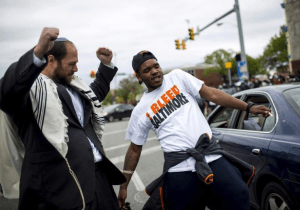It’s good to see Jews taking the side of the oppressed.
Rabbi Yerachmiel Shapiro, left, and Meach Johnson celebrate on Friday, May 1, 2015, after State’s Attorney Marilyn J. Mosby announced criminal charges against all six officers suspended after Freddie Gray suffered a fatal spinal injury while in police custody in Baltimore. (AP Photo/David Goldman)
The Jerusalem Report: “Residents shouted with joy, embraced and honked car horns on Friday on the same Baltimore streets where rioters had clashed with police earlier this week in anger over the death of a black man who suffered severe spinal injuries while in custody.”
Newsweek Aug. 19, 2014: Holocaust Survivor Hedy Epstein, Arrested in Ferguson Protest, Says Racism Is Alive in America
Rabbi Shmuel Herzfeld: Why a bunch of rabbis went to Baltimore to protest — and pray:
Rabbi Shapiro, myself and three of our rabbinic colleagues from a local Greater Washington Orthodox rabbinic organization known as The Beltway Vaad were invited to Baltimore by Rabbi Etan Mintz of B’nai Israel, a historic synagogue in Downtown Baltimore. He encouraged us to join his Circle of Unity gathering, which he had called for in response to last week’s riots.
We arrived not knowing what to expect and, truthfully, had concerns about whether our presence would be welcomed.
On the contrary, though, we were welcomed, literally, with open arms. Our experience that day — six Jewish clergy in a predominantly African-American neighborhood — was one of warmth and welcoming.
The Baltimore we found was vastly different from the one we, and most Americans, have seen portrayed over the last few days in the national media. As we walked the streets with our prayer shawls on our shoulders and kippot on our heads, we were stopped and embraced by total strangers. Together, we prayed for solidarity and unity in a way that made me feel more alive than my prayers that same morning in my own synagogue.
We spent much of our time listening to local citizens talk about the problems they were facing in their community.
Then at one point, we looked up and saw Rabbi Shapiro leading a prayer for a large group that had gathered around him in a circle. He was in the middle of the circle swaying with them in song and prayer. It was a brief, but genuine moment of community and brotherhood.
The more we dialogued, the more personal connections we made. More than 30 pastors from the community gathered on Saturday in prayer with Rabbi Mintz, and one pastor we met forged such a strong connection with Rabbi Mintz that the next day, Saturday, he came to B’nai Israel and led the entire congregation in song.
It should be obvious, but the more we got to know people in West Baltimore, the more we realized how much we have in common with them.
I prefer Jim Goad’s perspective:
To those who’d refer to last week’s Baltimore riots as “unrest” or even an “uprising,” the sort of urban ne’er-do-wells who punched reporters and smashed police cars and looted grocery stores and burned buildings were merely reacting to the economic exploitation that capitalism had foisted upon them and the relentless brain-bludgeoning racism that has forced generations of them to squirm in pain under white supremacy’s pale, unforgiving thumb.
No one could be bothered to explain how the walking dead who occupy a terrifying quotient of Baltimore’s no-go zones were being economically exploited. Unless I’m missing something, such people typically don’t have many belongings worth stealing nor any job skills worth exploiting. Unlike feelings, dollars can be measured, and such types tend to drain more dollars from the public till than they provide.
And the already threadbare “white supremacy” narrative crumbles—at least to those who are willing to listen—when one considers that half of Baltimore’s 3,000 cops are black. It falls apart even more disastrously seeing as how the city’s mayor is a black woman. Baltimore’s police chief and city council president are also black. The Baltimore City State’s Attorney is a black woman, and last week when she filed criminal charges against six police officers that were in some way involved in Gray’s death, three of those officers turned out to be black. The most serious charge—that of “second-degree depraved-heart murder”—was filed against a black male officer.

